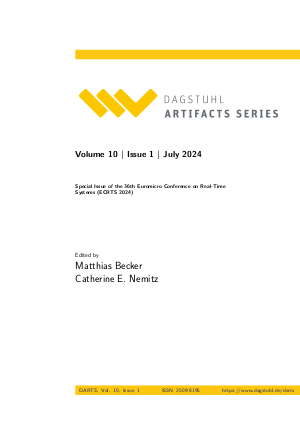DARTS, Volume 10, Issue 1
Special Issue of the 36th Euromicro Conference on Real-Time Systems (ECRTS 2024)
-
Part of:
Volume:
DARTS, Volume 10 (ECOOP 2024)
Conference: Euromicro Conference on Real-Time Systems (ECRTS)
Journal: Dagstuhl Artifacts Series (DARTS)

Editors
Publication Details
- published at: 2024-07-04
- Publisher: Schloss Dagstuhl – Leibniz-Zentrum für Informatik
- DBLP: db/journals/darts/darts10
Access Numbers
- Detailed Access Statistics available here
-
Total Document Accesses (updated on a weekly basis):
0PDF Downloads
Documents
Front Matter, Table of Contents, Artifact Evaluation Process, Artifact Evaluation Committee
Abstract
Cite as
Special Issue of the 36th Euromicro Conference on Real-Time Systems (ECRTS 2024). Dagstuhl Artifacts Series (DARTS), Volume 10, Issue 1, pp. 0:i-0:x, Schloss Dagstuhl – Leibniz-Zentrum für Informatik (2024)
Copy BibTex To Clipboard
@Article{becker_et_al:DARTS.10.1.0,
author = {Becker, Matthias and Nemitz, Catherine E.},
title = {{Front Matter, Table of Contents, Artifact Evaluation Process, Artifact Evaluation Committee}},
pages = {0:i--0:x},
journal = {Dagstuhl Artifacts Series},
ISBN = {978-3-95977-327-0},
ISSN = {2509-8195},
year = {2024},
volume = {10},
number = {1},
editor = {Becker, Matthias and Nemitz, Catherine E.},
publisher = {Schloss Dagstuhl -- Leibniz-Zentrum f{\"u}r Informatik},
address = {Dagstuhl, Germany},
URL = {https://drops.dagstuhl.de/entities/document/10.4230/DARTS.10.1.0},
URN = {urn:nbn:de:0030-drops-203223},
doi = {10.4230/DARTS.10.1.0},
annote = {Keywords: Front Matter, Table of Contents, Artifact Evaluation Process, Artifact Evaluation Committee}
}
Predictable GPU Sharing in Component-Based Real-Time Systems (Artifact)
Abstract
Cite as
Syed W. Ali, Zelin Tong, Joseph Goh, and James H. Anderson. Predictable GPU Sharing in Component-Based Real-Time Systems (Artifact). In Special Issue of the 36th Euromicro Conference on Real-Time Systems (ECRTS 2024). Dagstuhl Artifacts Series (DARTS), Volume 10, Issue 1, pp. 1:1-1:5, Schloss Dagstuhl – Leibniz-Zentrum für Informatik (2024)
Copy BibTex To Clipboard
@Article{ali_et_al:DARTS.10.1.1,
author = {Ali, Syed W. and Tong, Zelin and Goh, Joseph and Anderson, James H.},
title = {{Predictable GPU Sharing in Component-Based Real-Time Systems (Artifact)}},
pages = {1:1--1:5},
journal = {Dagstuhl Artifacts Series},
ISBN = {978-3-95977-327-0},
ISSN = {2509-8195},
year = {2024},
volume = {10},
number = {1},
editor = {Ali, Syed W. and Tong, Zelin and Goh, Joseph and Anderson, James H.},
publisher = {Schloss Dagstuhl -- Leibniz-Zentrum f{\"u}r Informatik},
address = {Dagstuhl, Germany},
URL = {https://drops.dagstuhl.de/entities/document/10.4230/DARTS.10.1.1},
URN = {urn:nbn:de:0030-drops-203236},
doi = {10.4230/DARTS.10.1.1},
annote = {Keywords: GPU locking protocols, real-time locking protocols, priority-inversion blocking, component-based systems}
}
Crêpe: Clock Reconfigurability for Preemption Control (Artifact)
Abstract
Cite as
Eva Dengler and Peter Wägemann. Crêpe: Clock Reconfigurability for Preemption Control (Artifact). In Special Issue of the 36th Euromicro Conference on Real-Time Systems (ECRTS 2024). Dagstuhl Artifacts Series (DARTS), Volume 10, Issue 1, pp. 2:1-2:3, Schloss Dagstuhl – Leibniz-Zentrum für Informatik (2024)
Copy BibTex To Clipboard
@Article{dengler_et_al:DARTS.10.1.2,
author = {Dengler, Eva and W\"{a}gemann, Peter},
title = {{Cr\^{e}pe: Clock Reconfigurability for Preemption Control (Artifact)}},
pages = {2:1--2:3},
journal = {Dagstuhl Artifacts Series},
ISBN = {978-3-95977-327-0},
ISSN = {2509-8195},
year = {2024},
volume = {10},
number = {1},
editor = {Dengler, Eva and W\"{a}gemann, Peter},
publisher = {Schloss Dagstuhl -- Leibniz-Zentrum f{\"u}r Informatik},
address = {Dagstuhl, Germany},
URL = {https://drops.dagstuhl.de/entities/document/10.4230/DARTS.10.1.2},
URN = {urn:nbn:de:0030-drops-203244},
doi = {10.4230/DARTS.10.1.2},
annote = {Keywords: energy-constrained real-time systems, time/energy tradeoff, system-on-chip, energy-aware real-time scheduling, resource minimization, preemption control, worst-case energy consumption (WCEC), worst-case execution-time (WCET), static whole-system analysis}
}
Autonomy Today: Many Delay-Prone Black Boxes (Artifact)
Abstract
Cite as
Sizhe Liu, Rohan Wagle, James H. Anderson, Ming Yang, Chi Zhang, and Yunhua Li. Autonomy Today: Many Delay-Prone Black Boxes (Artifact). In Special Issue of the 36th Euromicro Conference on Real-Time Systems (ECRTS 2024). Dagstuhl Artifacts Series (DARTS), Volume 10, Issue 1, pp. 3:1-3:3, Schloss Dagstuhl – Leibniz-Zentrum für Informatik (2024)
Copy BibTex To Clipboard
@Article{liu_et_al:DARTS.10.1.3,
author = {Liu, Sizhe and Wagle, Rohan and Anderson, James H. and Yang, Ming and Zhang, Chi and Li, Yunhua},
title = {{Autonomy Today: Many Delay-Prone Black Boxes (Artifact)}},
pages = {3:1--3:3},
journal = {Dagstuhl Artifacts Series},
ISBN = {978-3-95977-327-0},
ISSN = {2509-8195},
year = {2024},
volume = {10},
number = {1},
editor = {Liu, Sizhe and Wagle, Rohan and Anderson, James H. and Yang, Ming and Zhang, Chi and Li, Yunhua},
publisher = {Schloss Dagstuhl -- Leibniz-Zentrum f{\"u}r Informatik},
address = {Dagstuhl, Germany},
URL = {https://drops.dagstuhl.de/entities/document/10.4230/DARTS.10.1.3},
URN = {urn:nbn:de:0030-drops-203259},
doi = {10.4230/DARTS.10.1.3},
annote = {Keywords: autonomous driving, CUDA programming, locking protocols, POSIX thread, operating systems, machine learning systems, real-time systems}
}
The Omnivisor: A real-time static partitioning hypervisor extension for heterogeneous core virtualization over MPSoCs (Artifact)
Abstract
Cite as
Daniele Ottaviano, Francesco Ciraolo, Renato Mancuso, and Marcello Cinque. The Omnivisor: A real-time static partitioning hypervisor extension for heterogeneous core virtualization over MPSoCs (Artifact). In Special Issue of the 36th Euromicro Conference on Real-Time Systems (ECRTS 2024). Dagstuhl Artifacts Series (DARTS), Volume 10, Issue 1, pp. 4:1-4:7, Schloss Dagstuhl – Leibniz-Zentrum für Informatik (2024)
Copy BibTex To Clipboard
@Article{ottaviano_et_al:DARTS.10.1.4,
author = {Ottaviano, Daniele and Ciraolo, Francesco and Mancuso, Renato and Cinque, Marcello},
title = {{The Omnivisor: A real-time static partitioning hypervisor extension for heterogeneous core virtualization over MPSoCs (Artifact)}},
pages = {4:1--4:7},
journal = {Dagstuhl Artifacts Series},
ISBN = {978-3-95977-327-0},
ISSN = {2509-8195},
year = {2024},
volume = {10},
number = {1},
editor = {Ottaviano, Daniele and Ciraolo, Francesco and Mancuso, Renato and Cinque, Marcello},
publisher = {Schloss Dagstuhl -- Leibniz-Zentrum f{\"u}r Informatik},
address = {Dagstuhl, Germany},
URL = {https://drops.dagstuhl.de/entities/document/10.4230/DARTS.10.1.4},
URN = {urn:nbn:de:0030-drops-203267},
doi = {10.4230/DARTS.10.1.4},
annote = {Keywords: Mixed-Criticality, Embedded Virtualization, Real-Time Systems, MPSoCs.}
}
